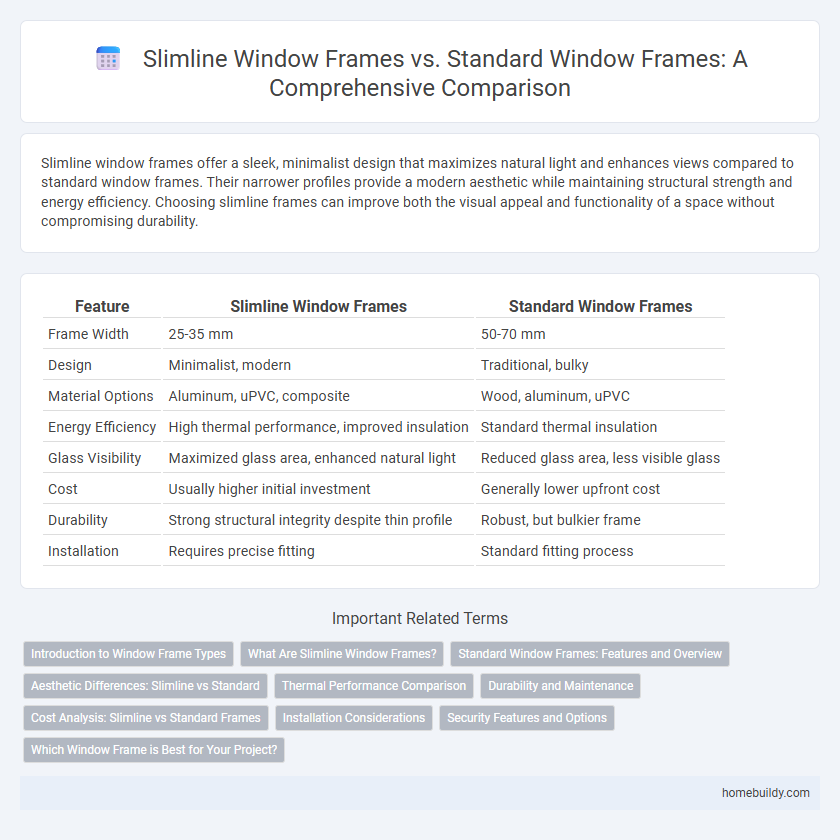Slimline window frames offer a sleek, minimalist design that maximizes natural light and enhances views compared to standard window frames. Their narrower profiles provide a modern aesthetic while maintaining structural strength and energy efficiency. Choosing slimline frames can improve both the visual appeal and functionality of a space without compromising durability.
Table of Comparison
| Feature | Slimline Window Frames | Standard Window Frames |
|---|---|---|
| Frame Width | 25-35 mm | 50-70 mm |
| Design | Minimalist, modern | Traditional, bulky |
| Material Options | Aluminum, uPVC, composite | Wood, aluminum, uPVC |
| Energy Efficiency | High thermal performance, improved insulation | Standard thermal insulation |
| Glass Visibility | Maximized glass area, enhanced natural light | Reduced glass area, less visible glass |
| Cost | Usually higher initial investment | Generally lower upfront cost |
| Durability | Strong structural integrity despite thin profile | Robust, but bulkier frame |
| Installation | Requires precise fitting | Standard fitting process |
Introduction to Window Frame Types
Slimline window frames offer a minimalist profile, enhancing natural light and creating a modern aesthetic compared to standard window frames, which are bulkier and more traditional. Slimline designs are typically crafted from materials like aluminum or steel, providing strength while occupying less visual space. Standard window frames, often made from wood or uPVC, prioritize insulation and durability but can limit the view due to their wider profiles.
What Are Slimline Window Frames?
Slimline window frames are designed with narrower profiles, offering a sleek and minimalist appearance compared to standard window frames. These frames maximize glass area, enhancing natural light and providing unobstructed views while maintaining structural integrity. Made from materials like aluminum or steel, slimline frames are ideal for modern architectural designs emphasizing aesthetics and energy efficiency.
Standard Window Frames: Features and Overview
Standard window frames typically feature robust construction using materials such as vinyl, aluminum, or wood, offering durability and reliable insulation. Their design usually includes wider profiles compared to slimline frames, providing enhanced structural support and better accommodation for thicker glazing options. These frames deliver superior thermal performance and noise reduction, making them ideal for both residential and commercial applications.
Aesthetic Differences: Slimline vs Standard
Slimline window frames feature narrower profiles that maximize glass area, creating a sleek, modern look with enhanced natural light and unobstructed views. Standard window frames have thicker profiles that provide a more traditional appearance, often adding a sense of solidity and durability to the window design. The minimalist aesthetic of slimline frames tends to complement contemporary architectural styles, while standard frames suit classic or conventional buildings.
Thermal Performance Comparison
Slimline window frames typically feature narrower profiles and more efficient insulation materials, resulting in enhanced thermal performance compared to standard window frames. They reduce heat transfer and improve energy efficiency, making them ideal for modern, eco-friendly buildings. The improved thermal break technology in slimline frames minimizes thermal bridging, significantly lowering heating and cooling costs.
Durability and Maintenance
Slimline window frames, typically made from high-quality aluminum or uPVC, offer enhanced durability due to their corrosion resistance and strong structural integrity compared to standard wooden frames. These frames require minimal maintenance, as they do not need regular painting or sealing, unlike traditional timber frames that are prone to rot and insect damage. The slim profile also reduces potential weak points, increasing longevity and preserving window performance over time.
Cost Analysis: Slimline vs Standard Frames
Slimline window frames typically cost 10-20% more than standard frames due to higher material and manufacturing expenses. However, the enhanced aesthetics and increased natural light can improve property value, potentially offsetting the initial price difference. Standard frames remain a budget-friendly choice with widespread availability and simpler installation processes.
Installation Considerations
Slimline window frames require precise measurements and careful handling during installation due to their thinner profiles, which can increase the risk of damage if not properly supported. Standard window frames, being bulkier and more robust, offer greater tolerance for minor installation errors and can be easier to secure in place. Choosing between slimline and standard frames depends on the skill level of the installer and the structural characteristics of the building.
Security Features and Options
Slimline window frames offer enhanced security features such as multi-point locking systems and reinforced steel cores, providing superior resistance against forced entry compared to standard window frames. These frames often incorporate laminated or toughened glass options, boosting impact resistance without compromising aesthetics. Standard frames typically rely on basic locking mechanisms and single-pane glass, making slimline designs a more secure choice for modern properties.
Which Window Frame is Best for Your Project?
Slimline window frames offer a sleek, modern aesthetic with narrower sightlines that maximize natural light and views, making them ideal for contemporary architectural designs. Standard window frames provide greater durability and insulation due to their thicker profiles, suitable for projects prioritizing energy efficiency and structural support. The best window frame depends on project requirements such as design style, thermal performance, and budget constraints.
Slimline window frames vs standard window frames Infographic

 homebuildy.com
homebuildy.com